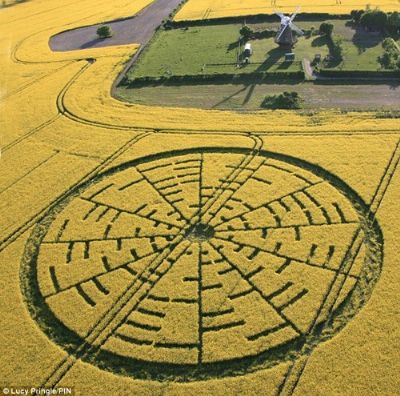Channelers and ufologists pretend that crop circles are not symbols intended as a ‘message to man.’ These deliberately created pictographs are signposts, or reference marks produced by aliens moving in space and time (back and forth/in and out), who are monitoring the course of event trajectories. The pictographs serve primarily as reference markings and for ‘event line’ orientation and are deliberately embedded in a short-lived, perishable medium so that man’s attention would not be attracted to specific locations.
Production of the circles occurs via two primary mechanisms:
- Macroscale: external area effects; heat and overpressure
- Microscale: internal plant stem effects; pressure changes and cellular damage.
Ultrasonics are produced as gasses escape the plant stem. The concominent drop in turgor pressure within the stem causes the plant to bend over. there is a gentle ‘swish swish’ sound as this effect is induced, en masse.
Some craft halt in the vicinity of the circles for what appears to be communications checks. On occasion, craft temporarily stop and conduct exploratory probing/testing in the vicinity of the circles.

It must be added that circles have given rise historically to various beliefs connected with the supernatural. for instance, the circles inspired the idea of the ‘elves’ green rings. The Nazca lines and, most noteworthy, Navajo sand paintings, were ideas born of attempts to copy the ‘marks of the Gods’, so as to evoke a visitation or response.
Crop circles are often created near ancient sites, and according to some along ley lines. According to this theory, crop circles would be the result of abnormal burst of electro-magnetical energy from the Earth.
Ley lines, or Leys, are alignments of ancient sites stretching across the landscape. Ancient sites or holy places may be situated in a straight line ranging from one or two to several miles in length. A ley may be identified simply by an aligned placing of marker sites, or it might be visible on the ground for all or part of its length by the remnants of an old straight track.
Ley Lines were ‘re-discovered’ in June 1921 by Alfred Watkins (1855-1935), a locally well-known and respected Herefordshire businessman, who while looking at a map for features of interest noticed a straight line that passed over hill tops through various points of interest, all of which were ancient. At the time of his discovery, Watkins had no theory about alignments but on that June afternoon saw “in a flash” a whole pattern of lines stretching across the landscape. Four years later, in 1925, he described his vision in a book he titled The Old Straight Track:
“Imagine a fairy chain stretched from mountain peak to mountain peak, as far as the eye could reach, and paid out until it reached the ‘high places’ of the earth at a number of ridges, banks, and knowls. Then visualise a mound, circular earthwork, or clump of trees, planted on these high points, and in low points in the valley other mounds ringed around with water to be seen from a distance. Then great standing stones brought to mark the way at intervals, and on a bank leading up to a mountain ridge or down to a ford the track cut deep so as to form a guiding notch on the skyline as you come up…. Here and there, at two ends of the way, a beacon fire used to lay out the track. With ponds dug on the line, or streams banked up into ‘flashes’ to form reflecting points on the beacon track so that it might be checked when at least once a year the beacon was fired on the traditional day. All these works exactly on the sighting line.”
In 1936, the British occultist Dion Fortune wrote a fictional book, a novel, called The Goat-Foot God, in which she put forward the notion of ‘lines of force’ connecting megalithic sites such as Avebury and Stonehenge in southern England. In 1938, Arthur Lawton, a member of the Straight Track Club, wrote a paper in which he claimed that leys were lines of cosmic force which could be dowsed. Through the 1970s and the 1980s, the idea of energy lines grew and grew and became a part of the New Age movement.
New agers claim that ley lines correspond to energy currents that cross the Earth and that the alleged energy is connected to changes in magnetic fields. Ancients built their temples on special places wher they could tap the energy.
From Places of Power, by Paul Devereux:
”The ancient sites of power were sometimes found, and sometimes deliberately constructed to mimic or enhance what could be found in nature. In either case, the forces of the natural world were used. And they were used for a variety of purposes, such as the promotion of fertility and for healing. But the over-riding purpos was the need to have gateways through which contact with spirit could be achieved. In the ancient world there were certain people who knew how to work with the physical world in order to create access to the spiritual.”
